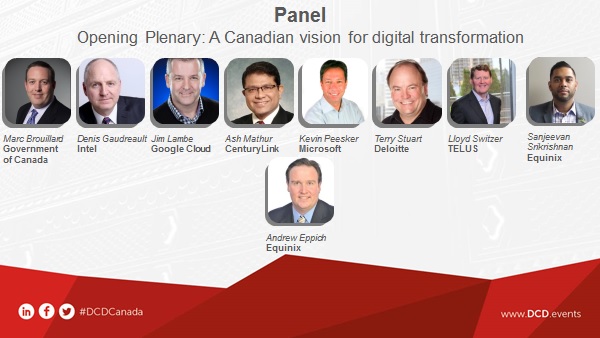At Datacenter Dynamics Connected Canada 4.0, held in Toronto this December, a plenary panel composed of key industry leaders from across Canada kicked off the conference with observations on country’s readiness for digital transformation. Experts from sectors ranging from telecom and technology to government and consulting, and including Marc Brouillard, CTO of the Government of Canada, Denis Gaudreault, country manager, Intel Canada, Jim Lambe, country manager, Google Cloud, Lloyd Switzer, SVP Network Transformation, TELUS, Kevin Peesker, president, Microsoft Canada, Ash Mathur, managing director, CenturyLink Canada, Andrew Eppich, managing director and Sanjeevan Srikrishnan, CTO, (respectively) for Equinix Canada , and Terry Stuart, chief innovation officer, Deloitte Canada, demonstrated surprising consistency on certain aspects of Canada’s prospects for digital transformation and global competitiveness.
Led in discussion by InsightaaS principal analyst Michael O’Neil, the experts registered strong agreement on the notion that Canada has some catching up to do on several fronts. At the same time, there was consensus on the proposition that Canada is also uniquely positioned to take on a leadership role in certain technology areas, such as artificial intelligence, Fintech and Blockchain.

In his welcome, Datacenter Dynamics EVP and conference chair Bruce Taylor cited statistics that the provided some interesting background for the opening panel. For example, in 2016, Canada slipped in Huawei’s Global Connectivity Index rankings from 12th to 14th spot among modern economies, surpassed by several countries in Europe and Asia-Pacific. “If I was the government, I would be concerned about that,” he said.
Taylor’s concern is also based on the expectation that the number of hyperscale cloud data centres globally will double by 2020 (from 2015). “By 2020, 92 percent of all compute workloads in the world will be in the cloud, and only eight per cent on premise,” Taylor said.
Another compelling future factor to consider is the network edge, which, Taylor added, is growing even more quickly than the cloud. “Over the next three years, there will be 50 billion connected devices worldwide. IoT demands compute processing be as close to the origination and consumption of data as possible. Data centres will look and behave much differently.”

Data will also contribute to opportunity and challenge. “Gartner says 90 percent of all data collected today is wasted. One retired IBM director told me it was more like 99 per cent,” Taylor told the audience. “That does not mean it doesn’t have a place. We haven’t yet learned how to clean, organize and use it. The second we learn that, it will cause another explosion in growth.”
Reflecting on some of these challenges, experts in the panel agreed that industry and government need to step up their pace to close the looming gap in digital transformation and global competitiveness. But they also pointed to technology’s ability to provide equal competitive ground.
“Most of the stats are pretty daunting depending on what side of the scale you want to look,” said Jim Lambe, country manager, Google Cloud. “Right now, we’re in the middle of the great equalizer with digitization and cloud. But that also represents the single largest opportunity for Canada because it allows us to compete with any other city in the world. It’s important for government to take advantage of the opportunity.”
Terry Stewart, chief innovation office at Deloitte had his own statistics to share on Canada’s performance on the tech investment side of the equation. “Canadian organizations invest 35 percent per capita less than the US in technology. We have to start getting over that.”
A recent World Economic Forum on the fourth Industrial Revolution provided even more damning research numbers, he added. “In looking at AI, IoT, robotics, 3D printing and outsourcing, only 13 percent of Canadian companies said they knew about them, had a strategy and were investing, while 35 percent had no clue. They weren’t worried, weren’t investing and not interested. Yet AI and IoT are changing everyone’s industry. We have to wake up the country or we will fall behind.”
Marc Brouillard, CTO for the Government of Canada, admitted that government in particular has some ground to cover, while making it clear that the issue is not rooted in systems or technology availability. “The problems we are trying to solve are business problems. When we start looking at digital transformation, we can’t forget that it’s about real world needs, such as getting passports faster or single address changes across all government agencies. We are being measured against Apple, Google, Netflix and Amazon and not meeting expectations. We must be active participants in digital innovation. But we can’t do it in silos.”
Stewart concluded, however, that the future is looking brighter. “As we look at exponential tech growth, AI is an absolutely amazing opportunity for Canada. We have three of the greatest minds in the field right here. AI is a no-brainer, so we have to double down on it and seize the day. Fintech offers another nice concentration of possibilities, as do agriculture and food processing.”
All were agreed that the roadmap needs to change, though. As Brouillard said, “We need capital to push incubators and accelerators. We need to ensure companies are funded and can learn how to drive at a much higher speed. We see there is talent, money and ideas, but how do we increase the cadence? Let’s go quickly, iterate and make things happen. Let’s not be afraid to fail when trying to make that cultural change. Organizations are all about risk aversion and protection. We have to take this seriously off course. But it should not be what holds us back.”








